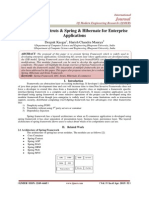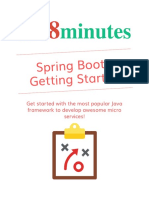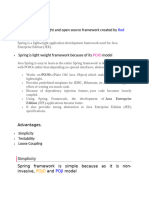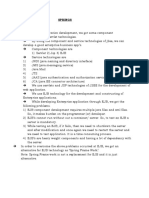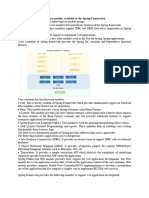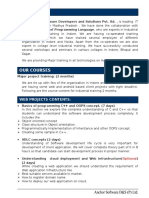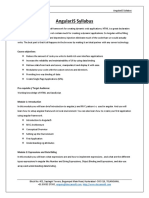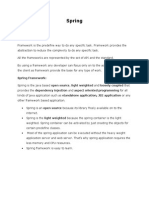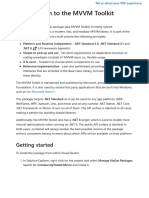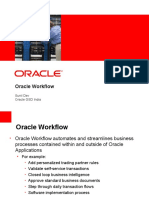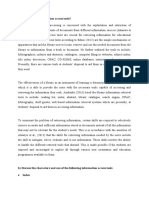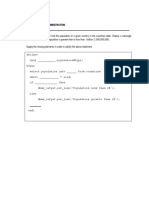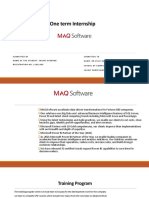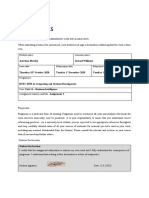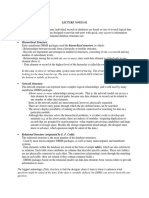Unit I
Unit I
Uploaded by
21jg1a0592.priyaCopyright:
Available Formats
Unit I
Unit I
Uploaded by
21jg1a0592.priyaOriginal Title
Copyright
Available Formats
Share this document
Did you find this document useful?
Is this content inappropriate?
Copyright:
Available Formats
Unit I
Unit I
Uploaded by
21jg1a0592.priyaCopyright:
Available Formats
IV B.Tech.- I Sem.
CSE-2/CSE-AI&ML (JNTUK-R20) API AND MICROSERVICES (Job Oriented Course)
UNIT I: Spring 5 Basics : Why Spring, What is Spring Framework, Spring Framework - Modules,
Configuring IoC container using Java-based configuration, Introduction To Dependency
Injection, Constructor Injection, Setter Injection, What is AutoScanning
What you will learn
Understand the features and modules of Spring Framework
Apply Inversion of Control to achieve Dependency Injection using Spring Framework
Develop Spring application using Java based configuration
Pre Contents
Java Programming Fundamentals
Java Language Features
Spring 5 Basics with Spring Boot
Spring Framework is one of the most popularly used open-source frameworks for developing
enterprise applications. Spring Core with Spring Boot course is designed to introduce the
fundamental concepts of Spring Framework with Spring Boot. This course provides an overview
of features, basic modules, and core concepts of Spring Framework using Spring Boot.
About Spring Basics
Spring is a popular open-source Java application development framework created by Rod Johnson.
Spring supports developing any kind of Java application such as standalone applications, web
applications, database-driven applications, and many more.
The basic objective of the framework was to reduce the complexity involved in the development of
enterprise applications. But today Spring is not limited to enterprise application development, many
projects are available under the Spring umbrella to develop different kinds of applications of today’s need
such as cloud-based applications, mobile applications, batch applications, etc. Spring framework helps in
developing a loosely coupled application that is simple, easily testable, reusable, and maintainable.
Spring is a Java-based framework for constructing web and enterprise applications. However, configuring
a Spring application is a tedious job. Even though it provides flexibility in bean configuration with multiple
ways such as XML, annotation, and Java-based configurations, there is no escape from the configuration.
Configuring the Spring features may need more time for developers and may distract the developers from
solving business problems.
Thanks to Spring Team for releasing Spring Boot, one of the topmost innovations in all the existing Spring
Framework. Spring Boot provides a new prototype for developing Spring applications with nominal effort.
Using Spring Boot, you will be able to develop Spring applications with extra agility and capacity to focus
on solving business needs with nominal (or possibly no) configuring.
In this course, we will discuss the core concepts of Spring Framework using Spring Boot that makes it
easy to create a production-grade, stand-alone application that we can just run.
Scenario: InfyTel Customer Application
Mrs. K Rohini, Assistant Professor, CSE Dept. ,GVPCEW AY:2023-24 Pg. 1
IV B.Tech.- I Sem. CSE-2/CSE-AI&ML (JNTUK-R20) API AND MICROSERVICES (Job Oriented Course)
In this course, we will look at a telecom application called InfyTel. InfyTel application is a Rest based
Application that provides functionality for adding, updating, and deleting a customer.
As the course proceeds, we will build this application incrementally to make it for learning the Spring core
concepts with Spring Boot.
InfyTel is built as a three-tier application which consists of
Presentation Layer
Service/Business Layer
Persistence Layer
The service layer of an enterprise application is the layer in which the business logic is implemented. It
interacts with the persistence layer and the presentation layer.
Mrs. K Rohini, Assistant Professor, CSE Dept. ,GVPCEW AY:2023-24 Pg. 2
IV B.Tech.- I Sem. CSE-2/CSE-AI&ML (JNTUK-R20) API AND MICROSERVICES (Job Oriented Course)
In this course Spring Core with Boot, we will see how to develop the Service/Business layer for this
application. Once you have completed this course you can then learn to build the Persistence layer using
Spring JDBC with Spring Boot course and, to build the Rest presentation layer using Spring REST
course.
The InfyTel Application Architecture is as follows
In this course, we will develop the service layer of this application and we will hardcode the persistence
layer.
Below are the classes used in the InfyTel application.
CustomerService.java -> Interface to define service methods
CustomerServiceImpl.java -> A service class which implements the CustomerService interface
Client.java-> A class for the main method.
CustomerRepository.java-> A class for the persistence layer where all CRUD operations are
performed.
Introduction to Spring Framework
Why Spring ?
Consider our InfyTel application here, we have a CustomerServiceImpl class which implements the
CustomerService interface.
1. package com.infy.service;
2.
3. public interface CustomerService {
4.
5. public String fetchCustomer();
6.
7. public String createCustomer(CustomerDto dto)
Mrs. K Rohini, Assistant Professor, CSE Dept. ,GVPCEW AY:2023-24 Pg. 3
IV B.Tech.- I Sem. CSE-2/CSE-AI&ML (JNTUK-R20) API AND MICROSERVICES (Job Oriented Course)
8.
9. }
The business logic of InfyTel application is implemented in this class. This class is used to perform
operations like creating a customer, deleting a customer, etc... CustomerServiceImpl class interacts with
CustomerRepository to perform the database related operations.
Below is the implementation of CustomerServiceImpl class:
CustomerServiceImpl.java
1. public class CustomerServiceImpl implements CustomerService{
2.
3. CustomerRepository customerRepository= new CustomerRepositoryImpl();
4.
5. public String createCustomer(CustomerDto dto) {
6. return customerRepository.createCustomer(dto);
7.
8. }
9.
10. public String fetchCustomer() {
11. return customerRepository.fetchCustomer();
12. }
13. }
In this implementation, CustomeServiceImpl depends on CustomerRepository. It also instantiates
CustomerRepositoryImpl class which makes it tightly coupled with CustomerRepositoryImpl class. This is
a bad design because of the following reasons:
If you want to unit test for createCustomer() method then you need a mock object of
CustomerRepository. But you cannot use a mock object because there is no way to substitute the
CustomerRepositoryImpl object that CustomerServiceImpl has. So testing CustomerServiceImpl
becomes difficult.
Also, you cannot use a different implementation of CustomerRepository other than
CustomerRepositoryImpl because of tight coupling.
So we need a more flexible solution where dependencies can be provided externally rather than a
dependent creating its own dependencies. Now let us see such an implementation
of CustomerServiceImpl class.
Consider the following modified implementation of CustomerServiceImpl class:
1. public class CustomerServiceImpl implements CustomerService {
2.
3. private CustomerRepository customerRepository;
4.
Mrs. K Rohini, Assistant Professor, CSE Dept. ,GVPCEW AY:2023-24 Pg. 4
IV B.Tech.- I Sem. CSE-2/CSE-AI&ML (JNTUK-R20) API AND MICROSERVICES (Job Oriented Course)
5. public CustomerServiceImpl(CustomerRepository customerRepository) {
6. this.customerRepository = customerRepository;
7. }
8.
9. public String createCustomer(CustomerDto dto) {
10. return customerRepository.createCustomer(dto);
11.
12. }
13.
14. }
15.
In this implementation, CustomerServiceImpl doesn’t create an object of the CustomerRepository.
Instead, it is giving an object of CustomerRepository at creation time as a constructor argument. You can
pass the object of any class that implements CustomerRepository interface at the time of object creation
of CustomerServiceImpl class as a constructor argument. This makes CustomerServiceImpl class loosely
coupled with CustomerRepositoryImpl class. So you can now easily test CustomerServiceImpl class by
substituting its CustomerRepositoryImpl object with a mock CustomerRepository. Also, you can use any
implementations of CustomerRepository inside CustomerServiceImpl.
This solution is more flexible and easy to test. But at the same time, it is tedious to manually wire together
with the dependencies. Also if you alter the dependencies you may have to change vast amounts of code.
So what is the solution?
We can use a technique called Dependency Injection (DI). It is a technique in which the responsibility of
creating and wiring the dependencies of a dependent class is externalized to the external framework or
library called dependency injection (DI) frameworks. So now the control over the construction and wiring
of an object graph is no longer resides with the dependent classes themselves. This reversal of
responsibilities is known as Inversion of Control(IoC). Dependency injection framework also called IoC
containers.
There are many third-party frameworks that are available for dependency injection such as Spring
Framework, Google Guice, Play Framework, etc. In this course, you will study about Spring Framework.
Besides dependency injection, there are many other advantages of using the Spring Framework which
you will study later in this course.
Note: Inversion of Control (IoC) represents the inversion of application responsibility of the object's
creation, initialization, dependency, and destruction from the application to the third party.
What is Spring Framework ?
Spring Framework is an open source Java application development framework that supports developing
all types of Java applications such as enterprise applications, web applications, cloud based applications,
and many more.
Java applications developed using Spring are simple, easily testable, reusable, and maintainable.
Spring modules do not have tight coupling on each other, the developer can pick and choose the modules
as per the need for building an enterprise application.
The following are the main features of the Spring Framework.
Mrs. K Rohini, Assistant Professor, CSE Dept. ,GVPCEW AY:2023-24 Pg. 5
IV B.Tech.- I Sem. CSE-2/CSE-AI&ML (JNTUK-R20) API AND MICROSERVICES (Job Oriented Course)
Spring Feature Description
Spring JARs are relatively small.
A basic Spring framework would be lesser than 10MB.
Light Weight
It can be deployed in Tomcat and they do not require heavy-
weight application servers.
The application is developed using POJOs.
Non-Invasive
No need to extend/implement any pre-defined classes.
Spring features like Dependency Injection and Aspect
Loosely Coupled
Oriented Programming help in loosely coupled code.
IoC takes care of the application object's life cycle along with
Inversion of Control(IoC)
their dependencies.
Spring Container takes care of object creation, initialization,
Spring Container
and managing object dependencies.
Promotes separation of supporting functions(concerns) such
Aspect Oriented
as logging, transaction, and security from the core business
Programming(AOP)
logic of the application.
We will explore all these features in detail as we go.
Spring Framework - Modules
Spring Framework 5.x has the following key module groups:
Core Container: These are core modules that provide key features of the Spring framework.
Data Access/Integration: These modules support JDBC and ORM data access approaches in
Spring applications.
Web: These modules provide support to implement web applications.
Others: Spring also provides few other modules such as the Test for testing Spring applications.
Core Container of Spring framework provides the Spring IoC container and Dependency Injection
features.
Mrs. K Rohini, Assistant Professor, CSE Dept. ,GVPCEW AY:2023-24 Pg. 6
IV B.Tech.- I Sem. CSE-2/CSE-AI&ML (JNTUK-R20) API AND MICROSERVICES (Job Oriented Course)
Core container has the following modules:
Core: This is the key module of Spring Framework which provides fundamental support on which
all other modules of the framework are dependent.
Bean: This module provides a basic Spring container called BeanFactory.
Context: This module provides one more Spring container called ApplicationContext which
inherits the basic features of the BeanFactory container and also provides additional features to
support enterprise application development.
Spring Expression Language (SpEL): This module is used for querying/manipulating object
values.
AOP (Aspect Oriented Programming) and aspects: These modules help in isolating cross-cutting
functionality from business logic.
We will discuss BeanFactory and ApplicationContext containers in detail later in this course.
The Data Access/Integration module of Spring provides different data access approaches.
Mrs. K Rohini, Assistant Professor, CSE Dept. ,GVPCEW AY:2023-24 Pg. 7
IV B.Tech.- I Sem. CSE-2/CSE-AI&ML (JNTUK-R20) API AND MICROSERVICES (Job Oriented Course)
The following modules support Data Access/Integration:
Java Database Connectivity (JDBC): It provides an abstract layer to support JDBC calls to
relational databases.
Object Relational Mapping (ORM): It provides integration support for popular ORM(Object-
Relational Mapping) solutions such as Hibernate, JPA, etc.
Transactions: It provides a simple transaction API which abstracts the complexity of underlying
repository specific transaction API's from the application.
Spring Framework Web module provides basic support for web application development. The Web
module has a web application context that is built on the application context of the core container. Web
module provides complete Model-View-Controller(MVC) implementation to develop a presentation tier of
the application and also supports a simpler way to implement RESTful web services.
Spring Framework provides the following modules to support web application development:
Web: This module has a container called web application context which inherits basic features
from ApplicationContext container and adds features to develop web based applications.
Webmvc: It provides the implementation of the MVC(model-view-controller) pattern to implement
the serverside presentation layer and also supports features to implement RESTful Web
Services.
WebFlux: Spring 5.0 introduced a reactive stack with a web framework called Spring WebFlux to
support Reactive programming in Spring's web layer and runs on containers such as Netty,
Undertow, and Servlet 3.1+.
WebSocket: It is used for 2 way communication between client and server in WebSocket based
web applications.
Spring Framework has few additional modules, test module is one of the most commonly used ones for
testing Spring applications.
Mrs. K Rohini, Assistant Professor, CSE Dept. ,GVPCEW AY:2023-24 Pg. 8
IV B.Tech.- I Sem. CSE-2/CSE-AI&ML (JNTUK-R20) API AND MICROSERVICES (Job Oriented Course)
Test: This module provides the required support to test Spring applications using TestNG or
JUnit.
Overall this is the big picture of Spring Framework. In this course, we will be discussing the highlighted
modules in detail.
Mrs. K Rohini, Assistant Professor, CSE Dept. ,GVPCEW AY:2023-24 Pg. 9
IV B.Tech.- I Sem. CSE-2/CSE-AI&ML (JNTUK-R20) API AND MICROSERVICES (Job Oriented Course)
The current version of Spring Framework is 5.x, the framework has been enhanced with new features
keeping core concepts the same as Spring 4.x.
At a high level, the new features of Spring Framework 5.x are:
JDK baseline update
Core framework revision
Reactive Programming Model: Introduces a new non-blocking web framework called Spring
WebFlux
Functional programming using Kotlin language support
Testing improvements by supporting integration with JUnit5
Let us look at Spring core relevant changes in detail:
JDK baseline update
The entire Spring framework 5.x codebase runs on Java 8 and designed to work with Java 9. Therefore,
Java 8 is the minimum requirement to work on Spring Framework 5.x
Core framework revision
The core Spring Framework 5.x has been revised, one of the main changes is Spring comes with its own
commons-logging through spring-jcl jar instead of standard Commons Logging.
There are few more changes in Spring 5.x with respect to library support and discontinued support, you
can refer to the Spring documentation for additional details.
Mrs. K Rohini, Assistant Professor, CSE Dept. ,GVPCEW AY:2023-24 Pg. 10
IV B.Tech.- I Sem. CSE-2/CSE-AI&ML (JNTUK-R20) API AND MICROSERVICES (Job Oriented Course)
Summary : Introduction to Spring
This module helped us learn the following:
What is the Spring Framework?
Why the Spring is needed?
What are the different modules of the Spring framework?
Spring IoC
As discussed earlier, usually it is the developer's responsibility to create the dependent application object
using the new operator in an application. Hence any change in the application dependency requires code
change and this results in more complexity as the application grows bigger.
Inversion of Control (IoC) helps in creating a more loosely coupled application. IoC represents the
inversion of the responsibility of the application object's creation, initialization, and destruction from the
application to the third party such as the framework. Now the third party takes care of application object
management and dependencies thereby making an application easy to maintain, test, and reuse.
There are many approaches to implement IoC, Spring Framework provides IoC implementation
using Dependency Injection(DI).
Let us now learn more about Spring IoC through Dependency Injection.
Spring Container managed application objects are called beans in Spring.
We need not create objects in dependency injection instead describe how objects should be created
through configuration.
DI is a software design pattern that provides better software design to facilitate loose coupling, reuse, and
ease of testing.
Benefits of Dependency Injection(DI):
Helps to create loosely coupled application architecture facilitating re-usability and easy testing.
Separation of responsibility by keeping code and configuration separately. Hence dependencies
can be easily modified using configuration without changing the code.
Allows to replace actual objects with mock objects for testing, this improves testability by writing
simple JUnit tests that use mock objects.
The core container module of the Spring Framework provides IoC using Dependency Injection.
Mrs. K Rohini, Assistant Professor, CSE Dept. ,GVPCEW AY:2023-24 Pg. 11
IV B.Tech.- I Sem. CSE-2/CSE-AI&ML (JNTUK-R20) API AND MICROSERVICES (Job Oriented Course)
The Spring container knows which objects to create and when to create through the additional details that
we provide in our application called Configuration Metadata.
1. Application logic is provided through POJO classes.
2. Configuration metadata consists of bean definitions that the container must manage.
3. IoC container produces objects required by the application using POJO classes and configuration
metadata. IoC container is of two types – BeanFactory and ApplicationContext.
Let us understand IoC containers and configuration metadata in detail on the go.
Spring provides two types of containers
Mrs. K Rohini, Assistant Professor, CSE Dept. ,GVPCEW AY:2023-24 Pg. 12
IV B.Tech.- I Sem. CSE-2/CSE-AI&ML (JNTUK-R20) API AND MICROSERVICES (Job Oriented Course)
BeanFactory:
It is the basic Spring container with features to instantiate, configure and manage the beans.
org.springframework.beans.factory.BeanFactory is the main interface representing a BeanFactory
container.
ApplicationContext:
ApplicationContext is another Spring container that is more commonly used in Spring
applications.
org.springframework.context.ApplicationContext is the main Interface representing an
ApplicationContext container.
It inherits the BeanFactory features and provides added features to support enterprise services
such as internationalization, validation, etc.
ApplicationContext is the preferred container for Spring application development. Let us look at
more details on the ApplicationContext container.
Let us now understand the differences between BeanFactory and ApplicationContext containers.
BeanFactory ApplicationContext
It does not support annotation based Support annotation based Dependency
Dependency Injection. Injection.
Support enterprise services such as
It does not support enterprise services.
validations, internationalization, etc.
By default, it supports Eager Loading.
By default, it supports Lazy Loading.
Beans are instantiated during load time.
// Loading ApplicationContext and
//Loading BeanFactory
instantiating bean
BeanFactory factory = new
ApplicationContext context = new
AnnotationConfigApplicationContext(Spring
AnnotationConfigApplicationContext(Sprin
Configuration.class);
gConfiguration.class);
// Instantiating bean during first access
// Instantiating bean during first access
using getBean()
using getBean()
CustomerServiceImpl service =
CustomerServiceImpl service =
(CustomerServiceImpl)
(CustomerServiceImpl)
factory.getBean("customerService");
context.getBean("customerService");
org.springframework.context.annotation.AnnotationConfigApplicationContext is one of the most
commonly used implementation of ApplicationContext.
Example: ApplicationContext container instantiation.
Mrs. K Rohini, Assistant Professor, CSE Dept. ,GVPCEW AY:2023-24 Pg. 13
IV B.Tech.- I Sem. CSE-2/CSE-AI&ML (JNTUK-R20) API AND MICROSERVICES (Job Oriented Course)
1. ApplicationContext context = new
AnnotationConfigApplicationContext(SpringConfiguration.class);
2. Object obj = context.getBean("customerService");
1. ApplicationContext container is instantiated by loading the configuration from the
SpringConfiguration.class which is available in the utility package of the application.
2. Accessing the bean with id "customerService" from the container.
AbstractApplicationContext
You can see a warning message as Resource leak: 'context' is never closed while using the
ApplicationContext type. This is for the reason that you don’t have a close method with BeanFactory or
even ApplicationContext. AbstractApplicationContext is an abstract implementation of the
ApplicationContext interface and it implements Closeable and AutoCloseable interfaces. To close the
application context and destroy all beans in its abstractApplicationContext has a close method that closes
this application context.
There are different ways to access bean in Spring
1. The traditional way of accessing bean based on bean id with explicit typecast
1. CustomerServiceImpl service = (CustomerServiceImpl)
context.getBean("customerService");
2. Accessing bean based on class type to avoid typecast if there is a unique bean of type in the container
1. CustomerServiceImpl service =
context.getBean(CustomerServiceImpl.class);
2.
3. Accessing bean through bean id and also type to avoid explicit typecast
1. CustomerServiceImpl service = context.getBean("customerService",
CustomerServiceImpl.class);
The Spring configuration metadata consists of definitions of the beans that the container must manage.
Mrs. K Rohini, Assistant Professor, CSE Dept. ,GVPCEW AY:2023-24 Pg. 14
IV B.Tech.- I Sem. CSE-2/CSE-AI&ML (JNTUK-R20) API AND MICROSERVICES (Job Oriented Course)
Spring allows providing the configuration metadata using :
XML Configuration
Annotation Based configuration
Java Based configuration
We will cover the Java based configuration in this course.
Configuring IoC container using Java-based configuration
The Java-based configuration metadata is provided in the Java class using the following
annotations:
@Configuration: The Java configuration class is marked with this annotation. This annotation
identifies this as a configuration class, and it’s expected to contain details on beans that are to be
created in the Spring application context.
@Bean: This annotation is used to declare a bean. The methods of configuration class that
creates an instance of the desired bean are annotated with this annotation. These methods are
called by the Spring containers during bootstrap and the values returned by these methods are
treated as Spring beans. By default, only one bean instance is created for a bean definition by the
Spring Container, and that instance is used by the container for the whole application lifetime.
For example, the SpringConfiguration class can be configured in a Java class using the above
annotations as follows :
1. @Configuration
2.
3. public class SpringConfiguration {
Mrs. K Rohini, Assistant Professor, CSE Dept. ,GVPCEW AY:2023-24 Pg. 15
IV B.Tech.- I Sem. CSE-2/CSE-AI&ML (JNTUK-R20) API AND MICROSERVICES (Job Oriented Course)
4.
5. @Bean
6. public CustomerServiceImpl customerService() {
7.
8. return new CustomerServiceImpl();
9. }
10. }
11.
By default, the bean name is the same as the name of the method in which the bean is
configured. So in the above code bean name is customerService. If you want to change the bean
name then you can either rename the method or provide a different name with the name attribute
as follows:
1. @Configuration
2. public class SpringConfiguration {
3.
4. @Bean(name="service")
5. public CustomerServiceImpl customerService() {
6.
7. return new CustomerServiceImpl();
8. }
9. }
Demo: Spring IOC
Highlights:
How to create Maven based Spring basic application
How to add required dependencies in POM.xml file
Demo Steps:
Let us understand the steps required to create a Maven project for Spring basic application using Spring
Tool Suite(STS)/Eclipse IDE.
Note: Screenshots of this demo have been taken from Eclipse IDE, however, the steps remain similar
even for the Spring Tool Suite IDE.
Step 1: Create a Maven project in Eclipse as shown below
Goto File > new > Maven Project, you would get the below screen
Mrs. K Rohini, Assistant Professor, CSE Dept. ,GVPCEW AY:2023-24 Pg. 16
IV B.Tech.- I Sem. CSE-2/CSE-AI&ML (JNTUK-R20) API AND MICROSERVICES (Job Oriented Course)
Step 2: Let the current workspace be chosen as the default location for the Maven project. Click on next.
Mrs. K Rohini, Assistant Professor, CSE Dept. ,GVPCEW AY:2023-24 Pg. 17
IV B.Tech.- I Sem. CSE-2/CSE-AI&ML (JNTUK-R20) API AND MICROSERVICES (Job Oriented Course)
Step 3: Choose maven-archetype-quickstart
Step 4: Provide groupId as com.infy, artifactId as demo1, and retain the default version which is 0.0.1-
SNAPSHOT.
We can customize the package names as per our needs. In this demo, the package name is provided as
com.infy. Click on the finish button to complete the project creation.
Mrs. K Rohini, Assistant Professor, CSE Dept. ,GVPCEW AY:2023-24 Pg. 18
IV B.Tech.- I Sem. CSE-2/CSE-AI&ML (JNTUK-R20) API AND MICROSERVICES (Job Oriented Course)
Step 5: New project along with a POM.xml file is created as shown below
Step 6: Add the below dependency in the POM.xml file.
1. <project xmlns="http://maven.apache.org/POM/4.0.0"
xmlns:xsi="http://www.w3.org/2001/XMLSchema-instance"
2. xsi:schemaLocation="http://maven.apache.org/POM/4.0.0
http://maven.apache.org/xsd/maven-4.0.0.xsd">
3. <modelVersion>4.0.0</modelVersion>
4. <groupId>com.infosys</groupId>
5. <artifactId>demo1-spring-ioc</artifactId>
6. <version>0.0.1-SNAPSHOT</version>
7. <packaging>jar</packaging>
8. <name>demo1-spring-ioc</name>
9. <url>http://maven.apache.org</url>
10. <properties>
11. <spring.version>5.0.5.RELEASE</spring.version>
12. <project.build.sourceEncoding>UTF-
8</project.build.sourceEncoding>
13. </properties>
14. <dependencies>
15. <!-- Spring Dependency -->
16. <dependency>
17. <groupId>org.springframework</groupId>
18. <artifactId>spring-context</artifactId>
19. <version>${spring.version}</version>
20. </dependency>
21. <dependency>
22. <groupId>junit</groupId>
23. <artifactId>junit</artifactId>
24. <version>3.8.1</version>
25. <scope>test</scope>
26. </dependency>
27. </dependencies>
28. </project>
29.
Step 7: If the dependencies are not getting downloaded automatically update the Maven project as
shown below
Mrs. K Rohini, Assistant Professor, CSE Dept. ,GVPCEW AY:2023-24 Pg. 19
IV B.Tech.- I Sem. CSE-2/CSE-AI&ML (JNTUK-R20) API AND MICROSERVICES (Job Oriented Course)
Step 8: Add the required project files in the respective packages
Highlights:
To understand Java Code Based configuration in Spring
To understand the application container instantiation for Java configuration
CustomerService.java
1. package com.infy.service;
2.
3. public interface CustomerService {
4. public String createCustomer();
5. }
6.
CustomerServiceImpl.java
Mrs. K Rohini, Assistant Professor, CSE Dept. ,GVPCEW AY:2023-24 Pg. 20
IV B.Tech.- I Sem. CSE-2/CSE-AI&ML (JNTUK-R20) API AND MICROSERVICES (Job Oriented Course)
1. package com.infy.service;
2.
3. public class CustomerServiceImpl implements CustomerService {
4.
5. public String createCustomer() {
6. return "Customer is successfully created";
7. }
8.
9. }
10.
SpringConfiguration.java
1. package com.infy.util;
2.
3. import org.springframework.context.annotation.Bean;
4. import org.springframework.context.annotation.Configuration;
5. import com.infy.service.CustomerServiceImpl;
6.
7. @Configuration
8.
9. public class SpringConfiguration {
10.
11. @Bean(name = "customerService")
12. public CustomerServiceImpl customerServiceImpl() {
13. return new CustomerServiceImpl();
14. }
15. }
16.
Client.java
1. package com.infy;
2.
3. import
org.springframework.context.annotation.AnnotationConfigApplicationConte
xt;
4. import org.springframework.context.support.AbstractApplicationContext;
5. import com.infy.service.CustomerServiceImpl;
6. import com.infy.util.SpringConfiguration;
7.
8. public class Client {
9. public static void main(String[] args) {
10. CustomerServiceImpl service = null;
11. AbstractApplicationContext context = new
AnnotationConfigApplicationContext(SpringConfiguration.class);
12. service = (CustomerServiceImpl)
context.getBean("customerService");
Mrs. K Rohini, Assistant Professor, CSE Dept. ,GVPCEW AY:2023-24 Pg. 21
IV B.Tech.- I Sem. CSE-2/CSE-AI&ML (JNTUK-R20) API AND MICROSERVICES (Job Oriented Course)
13. System.out.println(service.createCustomer());
14. context.close();
15. }
16. }
Output:
1. Customer is successfully created
Summary :Spring IOC
This module helped us learn the following:
What is Inversion of Control in Spring?
How to configure the IoC container using Java based configuration?
Introduction To Dependency Injection
Let us now understand in detail how to implement Dependency Injection in Spring.
For the previously discussed InfyTel Customer application, we defined CustomerService bean as shown
below
1. @Bean
2. public CustomerService customerService() {
3.
4. return new CustomerService();
5. }
This is the same as the below Java code wherein an instance is created and initialized with default values
using the default constructor.
1. CustomerService customerService = new CustomerService();
How do we initialize beans with some specific values in Spring?
This can be achieved through Dependency Injection in Spring.
Mrs. K Rohini, Assistant Professor, CSE Dept. ,GVPCEW AY:2023-24 Pg. 22
IV B.Tech.- I Sem. CSE-2/CSE-AI&ML (JNTUK-R20) API AND MICROSERVICES (Job Oriented Course)
Inversion of Control pattern is achieved through Dependency Injection (DI) in Spring. In Dependency
Injection, the developer need not create the objects but specify how they should be created through
configuration.
Spring container uses one of these two ways to initialize the properties:
Constructor Injection: This is achieved when the container invokes a parameterized
constructor to initialize the properties of a class
Setter Injection: This is achieved when the container invokes setter methods of a class to
initialize the properties after invoking a default constructor.
Constructor Injection
Let us consider the CustomerService class of InfyTel Customer application to understand constructor
injection.
CustomerService class has a count property, let us now modify this class to initialize count property
during bean instantiation using the constructor injection approach.
1. package com.infy.service;
2.
3. public class CustomerServiceImpl implements CustomerService {
4. private int count;
5.
6. public CustomerServiceImpl(int count) {
7. this.count = count;
8. }
9.
10. }
How do we define bean in the configuration to initialize values?
1. @Configuration
2. public class SpringConfiguration {
3. @Bean // CustomerService bean definition with bean dependencies
through constructor injection
4. public CustomerServiceImpl customerService() {
5. return new CustomerServiceImpl(20);
6. }
What is mandatory for constructor injection?
A parameterized constructor is required in the CustomerService class as we are injecting the values
through the constructor argument.
Can we use constructor injection to initialize multiple properties?
Mrs. K Rohini, Assistant Professor, CSE Dept. ,GVPCEW AY:2023-24 Pg. 23
IV B.Tech.- I Sem. CSE-2/CSE-AI&ML (JNTUK-R20) API AND MICROSERVICES (Job Oriented Course)
Yes, we can initialize more than one property.
So far, we learned how to inject primitive values using constructor injection in Spring. Now we will look
into inject object dependencies using Constructor injection.
Consider our InfyTel Customer application. CustomerServiceImpl.java class which is dependent on
CustomerRepository(class used to in persistence layer to perform CRUD operations ) object type to
call fetchCustomer() method.
1. package com.infy.service;
2. public class CustomerServiceImpl implements CustomerService {
3. // CustomerServiceImpl needs to contact CustomerRepository, hence
injecting the customerRepository dependency
4.
5. private CustomerRepository customerRepository;
6. private int count;
7. public CustomerServiceImpl() {
8. }
9.
10. public CustomerServiceImpl(CustomerRepository
customerRepository, int count) {
11. this.customerRepository = customerRepository;
12. this.count=count;
13. }
14. public String fetchCustomer() {
15. return customerRepository.fetchCustomer(count);
16. }
17.
18. public String createCustomer() {
19. return customerRepository.createCustomer();
20. }
21.
22. }
Observe in the above code, CustomerRepository property of CustomerSevice class has not been
initialized with any value in the code. This is because Spring dependency is going to be taken care of in
the configuration.
How do we inject object dependencies through configuration using constructor injection?
1. package com.infy.util;
2.
3. @Configuration
4. public class SpringConfiguration {
5.
6. @Bean// customerRepository bean definition
7. public CustomerRepository customerRepository() {
8. return new CustomerRepository();
9. }
10.
Mrs. K Rohini, Assistant Professor, CSE Dept. ,GVPCEW AY:2023-24 Pg. 24
IV B.Tech.- I Sem. CSE-2/CSE-AI&ML (JNTUK-R20) API AND MICROSERVICES (Job Oriented Course)
11. @Bean // CustomerServic bean definition with bean dependencies
through constructor injection
12. public CustomerServiceImpl customerService() {
13.
14. return new
CustomerServiceImpl(customerRepository(),20);
15. }
16. }
17.
Demo: Constructor Injection
Highlights:
Objective: To understand the constructor based dependency injection in Spring
Demo Steps:
SpringConfiguration .java
1. package com.infy.util;
2.
3. import org.springframework.context.annotation.Bean;
4. import org.springframework.context.annotation.Configuration;
5. import com.infy.repository.CustomerRepository;
6. import com.infy.service.CustomerServiceImpl;
7.
8. @Configuration
9.
10. public class SpringConfiguration {
11.
12. @Bean // Constructor Injection
13. public CustomerServiceImpl customerService() {
14.
15. return new CustomerServiceImpl(customerRepository(),
20);
16. }
17.
18. @Bean // Constructor Injection
19. public CustomerRepository customerRepository() {
20.
21. return new CustomerRepository();
22. }
23. }
24.
CustomerService.java
Mrs. K Rohini, Assistant Professor, CSE Dept. ,GVPCEW AY:2023-24 Pg. 25
IV B.Tech.- I Sem. CSE-2/CSE-AI&ML (JNTUK-R20) API AND MICROSERVICES (Job Oriented Course)
1. package com.infy.service;
2.
3. public interface CustomerService {
4. public String fetchCustomer();
5. public String createCustomer();
6. }
7.
CustomerServiceImpl.java
1. package com.infy.service;
2.
3. import com.infy.repository.CustomerRepository;
4.
5. public class CustomerServiceImpl implements CustomerService {
6.
7. private int count;
8. private CustomerRepository repository;
9.
10. public CustomerServiceImpl(CustomerRepository repository, int
count) {
11. this.count = count;
12. this.repository = repository;
13. }
14.
15. public String fetchCustomer() {
16. return repository.fetchCustomer(count);
17. }
18.
19. public String createCustomer() {
20. return repository.createCustomer();
21. }
22.
23. }
24.
CustomerRepository.java
1. package com.infy.repository;
2.
3. public class CustomerRepository {
4.
5. public String fetchCustomer(int count) {
6. return " The no of customers fetched are : " + count;
7. }
8.
9. public String createCustomer() {
10. return "Customer is successfully created";
Mrs. K Rohini, Assistant Professor, CSE Dept. ,GVPCEW AY:2023-24 Pg. 26
IV B.Tech.- I Sem. CSE-2/CSE-AI&ML (JNTUK-R20) API AND MICROSERVICES (Job Oriented Course)
11. }
12.
13. }
14.
Client.java
1. package com.infy;
2.
3. import
org.springframework.context.annotation.AnnotationConfigApplicationConte
xt;
4. import org.springframework.context.support.AbstractApplicationContext;
5. import com.infy.service.CustomerServiceImpl;
6. import com.infy.util.SpringConfiguration;
7.
8. public class Client {
9. public static void main(String[] args) {
10. CustomerServiceImpl service = null;
11. AbstractApplicationContext context = new
AnnotationConfigApplicationContext(SpringConfiguration.class);
12. service = (CustomerServiceImpl)
context.getBean("customerService");
13. System.out.println(service.fetchCustomer());
14. context.close();
15.
16. }
17. }
18.
Output:
1. The no of customers fetched are : 20
Setter Injection
Let us now understand Setter Injection in Spring.
In Setter Injection, Spring invokes setter methods of a class to initialize the properties after invoking a
default constructor.
How can we use setter injection to inject values for the primitive type of properties?
Consider the below example to understand setter injection for primitive types.
Mrs. K Rohini, Assistant Professor, CSE Dept. ,GVPCEW AY:2023-24 Pg. 27
IV B.Tech.- I Sem. CSE-2/CSE-AI&ML (JNTUK-R20) API AND MICROSERVICES (Job Oriented Course)
Following the CustomerServiceImpl class has a count property, let us see how to initialize this property
during bean instantiation using the setter injection approach.
1. package com.infy.service;
2. public class CustomerServiceImpl implements CustomerService {
3. private int count;
4. public int getCount() {
5. return count;
6. }
7. public void setCount(int count) {
8. this.count = count;
9. }
10. public CustomerServiceImpl(){
11. }
12. }
How do we define bean in the configuration to initialize values?
1. package com.infy.util;
2. @Configuration
3.
4. public class SpringConfiguration {
5.
6.
7. @Bean // CustomerService bean definition using Setter Injection
8. public CustomerServiceImpl customerService() {
9. CustomerServiceImpl customerService = new
CustomerServiceImpl();
10. customerService.setCount(10);
11. return customerService;
12. }
13. }
What is mandatory to implement setter injection?
Default constructor and setter methods of respective dependent properties are required in the
CustomerServiceImpl class. For setter injection, Spring internally uses the default constructor to
create a bean and then invokes a setter method of the respective property based on the name
attribute in order to initialize the values.
So far, we learned how to inject primitive values using setter injection in Spring.
How do we inject object dependencies using setter injection?
Consider the CustomerServiceImpl class of InfyTel Customer application.
Mrs. K Rohini, Assistant Professor, CSE Dept. ,GVPCEW AY:2023-24 Pg. 28
IV B.Tech.- I Sem. CSE-2/CSE-AI&ML (JNTUK-R20) API AND MICROSERVICES (Job Oriented Course)
1. package com.infy.service;
2. public class CustomerServiceImpl implements CustomerService
{
3. private CustomerRepository customerRepository;
4. private int count;
5.
6. public CustomerRepository getCustomerRepository() {
7. return customerRepository;
8. }
9.
10. public void setCustomerRepository(CustomerRepository
customerRepository) {
11. this.customerRepository = customerRepository;
12. }
13.
14. public int getCount() {
15. return count;
16. }
17.
18. public void setCount(int count) {
19. this.count = count;
20. }
21.
22. }
23.
How do we inject object dependencies through configuration using setter injection?
1. package com.infy.util;
2. @Configuration
3.
4. public class SpringConfiguration {
5.
6. @Bean
7. public CustomerRepository customerRepository() {
8. return new CustomerRepository();
9. }
10.
11. @Bean // Setter Injection
12. public CustomerServiceImpl customerService() {
13. CustomerServiceImpl customerService = new
CustomerServiceImpl();
14. customerService.setCount(10);
15.
customerService.setCustomerRepository(customerRepository());
16. return customerService;
17. }
Mrs. K Rohini, Assistant Professor, CSE Dept. ,GVPCEW AY:2023-24 Pg. 29
IV B.Tech.- I Sem. CSE-2/CSE-AI&ML (JNTUK-R20) API AND MICROSERVICES (Job Oriented Course)
18. }
Demo: Setter Injection
Highlights:
Objective: To understand the setter based dependency injection in Spring
Demo Steps:
SpringConfiguration .java
1. package com.infy.util;
2.
3. import org.springframework.context.annotation.Bean;
4. import org.springframework.context.annotation.Configuration;
5. import com.infy.repository.CustomerRepository;
6. import com.infy.service.CustomerServiceImpl;
7.
8. @Configuration
9.
10. public class SpringConfiguration {
11.
12. @Bean // Setter Injection
13. public CustomerRepository customerRepository() {
14. CustomerRepository customerRepository = new
CustomerRepository();
15. return customerRepository;
16. }
17.
18. @Bean // Setter Injection
19. public CustomerServiceImpl customerService() {
20. CustomerServiceImpl customerService = new
CustomerServiceImpl();
21. customerService.setCount(10);
22. customerService.setRepository(customerRepository());
23. return customerService;
24. }
25. }
26.
CustomerService.java
1. package com.infy.service;
2.
3. public interface CustomerService {
4. public String fetchCustomer();
Mrs. K Rohini, Assistant Professor, CSE Dept. ,GVPCEW AY:2023-24 Pg. 30
IV B.Tech.- I Sem. CSE-2/CSE-AI&ML (JNTUK-R20) API AND MICROSERVICES (Job Oriented Course)
5. public String createCustomer();
6. }
7.
CustomerServiceImpl.java
1. package com.infy.service;
2.
3. import com.infy.repository.CustomerRepository;
4.
5. public class CustomerServiceImpl implements CustomerService {
6.
7. private int count;
8. private CustomerRepository repository;
9.
10. public CustomerServiceImpl() {
11. }
12.
13. public void setCount(int count) {
14. this.count = count;
15. }
16.
17. public void setRepository(CustomerRepository repository) {
18. this.repository = repository;
19. }
20.
21. public String fetchCustomer() {
22. return repository.fetchCustomer(count);
23. }
24.
25. public String createCustomer() {
26. return repository.createCustomer();
27. }
28.
29. }
30.
CustomerRepository.java
1. package com.infy.repository;
2.
3. public class CustomerRepository {
4.
5. public String fetchCustomer(int count) {
6. return " The no of customers fetched are : " + count;
7. }
8.
9. public String createCustomer() {
Mrs. K Rohini, Assistant Professor, CSE Dept. ,GVPCEW AY:2023-24 Pg. 31
IV B.Tech.- I Sem. CSE-2/CSE-AI&ML (JNTUK-R20) API AND MICROSERVICES (Job Oriented Course)
10. return "Customer is successfully created";
11. }
12.
13. }
14.
Client.java
1. package com.infy;
2.
3. import
org.springframework.context.annotation.AnnotationConfigApplicationConte
xt;
4. import org.springframework.context.support.AbstractApplicationContext;
5. import com.infy.service.CustomerServiceImpl;
6. import com.infy.util.SpringConfiguration;
7.
8. public class Client {
9. public static void main(String[] args) {
10. CustomerServiceImpl service = null;
11. AbstractApplicationContext context = new
AnnotationConfigApplicationContext(SpringConfiguration.class);
12. service = (CustomerServiceImpl)
context.getBean("customerService");
13. System.out.println(service.fetchCustomer());
14. context.close();
15. }
16. }
17.
Output:
1. The no of customers fetched are : 10
Summary: DI
This module helped us in learning the following:
What is Dependency Injection?
Different types of dependency injection in Spring
Setter Dependency Injection
Constructor Dependency Injection
What is AutoScanning?
Mrs. K Rohini, Assistant Professor, CSE Dept. ,GVPCEW AY:2023-24 Pg. 32
IV B.Tech.- I Sem. CSE-2/CSE-AI&ML (JNTUK-R20) API AND MICROSERVICES (Job Oriented Course)
As discussed in the previous example as a developer you have to declare all the bean definition
in SpringConfiguration class so that Spring container can detect and register your beans as below
:
1. @Configuration
2. public class SpringConfiguration {
3. @Bean
4. public CustomerRepository customerRepository() {
5. return new CustomerRepository();
6. }
7. @Bean
8. public CustomerServiceImpl customerService() {
9.
10. return new CustomerServiceImpl();
11. }
12. }
Is any other way to eliminate this tedious beans declaration?
Yes, Spring provides a way to automatically detect the beans to be injected and avoid even the
bean definitions within the Spring configuration file through Auto Scanning. In Auto Scanning,
Spring Framework automatically scans, detects, and instantiates the beans from the specified
base package, if there is no declaration for the beans in the SpringConfiguration class.
So your SpringConfiguration class will be looking as below:
1. @Configuration
2. @ComponentScan(basePackages="com.infy")
3. public class SpringConfiguration {
4.
5. }
Component scanning isn’t turned on by default, however. You have to annotate the configuration class
with @ComponentScan annotation to enable component scanning as follows:
1. @Configuration
2. @ComponentScan
3. public class SpringConfiguration {
4. }
5.
Mrs. K Rohini, Assistant Professor, CSE Dept. ,GVPCEW AY:2023-24 Pg. 33
IV B.Tech.- I Sem. CSE-2/CSE-AI&ML (JNTUK-R20) API AND MICROSERVICES (Job Oriented Course)
In the above code, Spring will scan the package that contains SpringConfig class and it subpackages for
beans. But if you want to scan a different package or multiple packages then you can specify this with the
basePackages attribute as follows:
1. @Configuration
2. @ComponentScan(basePackages = "com.infy.service,com.infy.repository")
3. public class SpringConfiguration {
4. }
5.
Spring uses @ComponentScan annotation for the auto scan feature. It looks for classes with the
stereotype annotations and creates beans for such classes automatically.
So what are Stereotype annotations?
Stereotype annotations denote the roles of types or methods at the conceptual level.
Stereotype annotations are @Component, @Service, @Repository,
and @Controller annotations.
These annotations are used for auto-detection of beans using @ComponentScan.
The Spring stereotype @Component is the parent stereotype.
The other stereotypes are the specialization of @Component annotation.
Annotation Usage
@Component It indicates the class(POJO class) as a Spring component.
@Service It indicates the Service class(POJO class) in the business layer.
It indicates the Repository class(POJO class in Spring DATA) in the
@Repository
persistence layer.
It indicates the Controller class(POJO class in Spring MVC) in the
@Controller
presentation layer.
@Component is a generic stereotype for any Spring-managed component.
@Repository, @Service, and @Controller are specializations of @Component for more specific
use cases.
@Component should be used when your class does not fall into either of three categories
i.e. Controllers, Services, and DAOs.
@Component: It is a general purpose annotation to mark a class as a Spring-managed bean.
1. @Component
2. public class CustomerLogging{
3. //rest of the code
4. }
5.
Mrs. K Rohini, Assistant Professor, CSE Dept. ,GVPCEW AY:2023-24 Pg. 34
IV B.Tech.- I Sem. CSE-2/CSE-AI&ML (JNTUK-R20) API AND MICROSERVICES (Job Oriented Course)
@Service - It is used to define a service layer Spring bean. It is a specialization of the @Component
annotation for the service layer.
1. @Service
2. public class CustomerSeviceImpl implements CustomerService {
3. //rest of the code
4. }
5.
@Repository - It is used to define a persistence layer Spring bean. It is a specialization of
the @Component annotation for the persistence layer.
1. @Repository
2. public class CustomerRepositoryImpl implements CustomerRepository {
3. //rest of the code
4. }
5.
@Controller - It is used to define a web component. It is a specialization of the @Component annotation
for the presentation layer.
1. @Controller
2. public class CustomerController {
3. //rest of the code
4. }
5.
By default, the bean names are derived from class names with a lowercase initial character. Therefore,
your above defined beans have the names customerController, customerServiceImpl, and
customerRepositoryImpl. It is also possible to give a specific name with a value attribute in those
annotations as follows:
1. @Repository(value="customerRepository")
2. public class CustomerRepositoryImpl implements CustomerRepository {
3. //rest of the code
4. }
Note: As a best practice, use @Service for the service layer, @Controller for the
Presentation layer, and @Repository for the Persistence layer.
Demo: AutoScanning
Mrs. K Rohini, Assistant Professor, CSE Dept. ,GVPCEW AY:2023-24 Pg. 35
IV B.Tech.- I Sem. CSE-2/CSE-AI&ML (JNTUK-R20) API AND MICROSERVICES (Job Oriented Course)
Highlights:
Objective: To understand the AutoScanning feature in Spring
Demo Steps:
SpringConfiguration .java
1. package com.infy.util;
2.
3. import org.springframework.context.annotation.ComponentScan;
4. import org.springframework.context.annotation.Configuration;
5.
6. @Configuration
7. @ComponentScan(basePackages="com.infy")
8. public class SpringConfiguration {
9.
10. }
11.
CustomerService.java
1. package com.infy.service;
2.
3. public interface CustomerService {
4. public String fetchCustomer(int count);
5. public String createCustomer();
6. }
7.
CustomerServiceImpl.java
1. package com.infy.service;
2.
3. import org.springframework.beans.factory.annotation.Value;
4. import org.springframework.stereotype.Service;
5.
6. @Service("customerService")
7. public class CustomerServiceImpl implements CustomerService {
8.
9. @Value("10")
10. private int count;
11.
12. public String fetchCustomer(int count) {
13. return " The no of customers fetched are : " + count;
14. }
15.
Mrs. K Rohini, Assistant Professor, CSE Dept. ,GVPCEW AY:2023-24 Pg. 36
IV B.Tech.- I Sem. CSE-2/CSE-AI&ML (JNTUK-R20) API AND MICROSERVICES (Job Oriented Course)
16. public String createCustomer() {
17. return "Customer is successfully created";
18. }
19.
20. }
21.
Client.java
1. package com.infy;
2.
3.
4. import
org.springframework.context.annotation.AnnotationConfigApplicationConte
xt;
5. import org.springframework.context.support.AbstractApplicationContext;
6. import com.infy.service.CustomerServiceImpl;
7. import com.infy.util.SpringConfiguration;
8.
9. public class Client {
10. public static void main(String[] args) {
11. CustomerServiceImpl service = null;
12.
13. AbstractApplicationContext context = new
AnnotationConfigApplicationContext(SpringConfiguration.class);
14. service = (CustomerServiceImpl)
context.getBean("customerService");
15.
16. System.out.println(service.createCustomer());
17. context.close();
18. }
19. }
20.
Output:
1. Customer is successfully created
Summary : AutoScanning
This module helped us in learning the following:
Why AutoScanning is needed?
The annotations used for autoscanning.
Mrs. K Rohini, Assistant Professor, CSE Dept. ,GVPCEW AY:2023-24 Pg. 37
IV B.Tech.- I Sem. CSE-2/CSE-AI&ML (JNTUK-R20) API AND MICROSERVICES (Job Oriented Course)
Mrs. K Rohini, Assistant Professor, CSE Dept. ,GVPCEW AY:2023-24 Pg. 38
You might also like
- Business Process Support ONGOINGDocument224 pagesBusiness Process Support ONGOINGQuantum MusicsNo ratings yet
- Silo - Tips Best Practices For Running Temenos t24 On Microsoft SQL Server and Windows ServerDocument60 pagesSilo - Tips Best Practices For Running Temenos t24 On Microsoft SQL Server and Windows Servernd0906No ratings yet
- Micros Opera Vision XLExercisesDocument38 pagesMicros Opera Vision XLExercisesRick Purewal 'Rick P'75% (4)
- ASP Net Core MVCDocument21 pagesASP Net Core MVCAlvaro OleasNo ratings yet
- Getting started with Spring Framework: A Hands-on Guide to Begin Developing Applications Using Spring FrameworkFrom EverandGetting started with Spring Framework: A Hands-on Guide to Begin Developing Applications Using Spring FrameworkRating: 4.5 out of 5 stars4.5/5 (2)
- Omnitrend: Maximizing System Availability Optimizing Production ProcessesDocument7 pagesOmnitrend: Maximizing System Availability Optimizing Production Processesodi odianNo ratings yet
- UNIT-1 material (1)Document26 pagesUNIT-1 material (1)reddysrinivasa346No ratings yet
- Integration of Struts & Spring & Hibernate For Enterprise ApplicationsDocument8 pagesIntegration of Struts & Spring & Hibernate For Enterprise ApplicationsIJMERNo ratings yet
- SpringBoot GettingStarted PDFDocument107 pagesSpringBoot GettingStarted PDFArun Kumar100% (3)
- Isolation Means: Onetariga: Develop Web Application That Enables A Clean Separation of CodeDocument20 pagesIsolation Means: Onetariga: Develop Web Application That Enables A Clean Separation of Codepravallika dasariNo ratings yet
- Fullstack - Cafe - Tech Interview Plan: Q1: What Is Spring?Document6 pagesFullstack - Cafe - Tech Interview Plan: Q1: What Is Spring?mukesh singhNo ratings yet
- 61 Essential ASP - NET Core Interview Questions and AnswersDocument11 pages61 Essential ASP - NET Core Interview Questions and AnswersShoeb BNo ratings yet
- 10 - Silver Light Patterns - Using MVVMDocument19 pages10 - Silver Light Patterns - Using MVVMAvinash PathakNo ratings yet
- FAQ Ans-1 (1)_20211006_155520434Document10 pagesFAQ Ans-1 (1)_20211006_155520434kapildudhe0No ratings yet
- Spring Notes & ProgramsDocument125 pagesSpring Notes & Programs2100090063csitNo ratings yet
- Spring and SpringbootDocument12 pagesSpring and SpringbootShubhamNo ratings yet
- Spring CloudDocument27 pagesSpring CloudAnuj TripathiNo ratings yet
- Project Round Java QuestionAnswerDocument7 pagesProject Round Java QuestionAnswerRadheshyam NayakNo ratings yet
- 15 Must-Know Spring MVC Interview QuestionsDocument14 pages15 Must-Know Spring MVC Interview QuestionsRahul PawarNo ratings yet
- ASP Net MVC 3tierDocument12 pagesASP Net MVC 3tierAbdhal GaluNo ratings yet
- TO Spring MVC: A Report On Industrial Training atDocument14 pagesTO Spring MVC: A Report On Industrial Training atRishabh SinghNo ratings yet
- Angular InterviewquestionsDocument6 pagesAngular InterviewquestionsalankarpNo ratings yet
- SpringsDocument58 pagesSpringsNEERAJ885No ratings yet
- Spring Security Framework Focuses On Providing Both Authentication and Authorization in Java Applications. It Also Takes Care of Most of The Common Security Vulnerabilities Such As CSRF AttackDocument31 pagesSpring Security Framework Focuses On Providing Both Authentication and Authorization in Java Applications. It Also Takes Care of Most of The Common Security Vulnerabilities Such As CSRF AttackPrasanta ChatterjeeNo ratings yet
- Angular Training + Practice ExcerciseDocument77 pagesAngular Training + Practice Excercisepankajbhakarkct99No ratings yet
- Spring Hibernate WebservicesDocument44 pagesSpring Hibernate WebservicesNitesh KumarNo ratings yet
- International Conference On Emanations in Modern Engineering Science and Management (ICEMESM-2017) ISSN: 2321-8169 Volume: 5 Issue: 3 52 - 54Document3 pagesInternational Conference On Emanations in Modern Engineering Science and Management (ICEMESM-2017) ISSN: 2321-8169 Volume: 5 Issue: 3 52 - 54Ameer ShajahanNo ratings yet
- Good?Document6 pagesGood?venkatbjNo ratings yet
- MVC 1Document87 pagesMVC 1Anil KumarNo ratings yet
- Literature SurveyDocument4 pagesLiterature SurveyVISHAL BHOJWANINo ratings yet
- Mid ApiDocument18 pagesMid Api4219- RupaNo ratings yet
- Major Training Final1Document6 pagesMajor Training Final1Akhilesh KhareNo ratings yet
- Spring Interview Questions and AnswersDocument74 pagesSpring Interview Questions and AnswersPintanaNo ratings yet
- Dependency Injection in Python. Building Flexible and Testable - by Patrick Kalkman - ITNEXTDocument18 pagesDependency Injection in Python. Building Flexible and Testable - by Patrick Kalkman - ITNEXTHồ Bảo QuốcNo ratings yet
- The ASP Dotent Core OOPsDocument23 pagesThe ASP Dotent Core OOPsJoshi RamNo ratings yet
- Spring FrameworkDocument53 pagesSpring Frameworkswapna jrNo ratings yet
- 8580bf5e 586f 455b 9b04 D2477a6c6bbgfg7 - AngularJS - Syllabus - BestDotNetTrainingDocument4 pages8580bf5e 586f 455b 9b04 D2477a6c6bbgfg7 - AngularJS - Syllabus - BestDotNetTrainingAnuj KaushikNo ratings yet
- MVVM Quickstart Using The Prism Library 5.0 For WPF: #!155chartopicsummary!#Document10 pagesMVVM Quickstart Using The Prism Library 5.0 For WPF: #!155chartopicsummary!#thorirNo ratings yet
- Angular1 (12 Files Merged)Document12 pagesAngular1 (12 Files Merged)candaceswissNo ratings yet
- Course Introduction Course Outline Creating First Project Controller in MVC Views in MVCDocument21 pagesCourse Introduction Course Outline Creating First Project Controller in MVC Views in MVCFaryal AftabNo ratings yet
- bioDocument21 pagesbiosasel54310No ratings yet
- Arnav MLOPSLab05Document5 pagesArnav MLOPSLab05Atomic MoleNo ratings yet
- Java Design PatternsDocument6 pagesJava Design PatternssubhjitNo ratings yet
- Design Pattern Interview Questions Part 1Document15 pagesDesign Pattern Interview Questions Part 1Biru C. SainjuNo ratings yet
- Design PatternsDocument2 pagesDesign Patternspratik deshmukhNo ratings yet
- Spring: FrameworkDocument47 pagesSpring: FrameworkMelissa AndersonNo ratings yet
- Top 7 Spring Boot Design Patterns Unveiled - by Dharmendra Awasthi - Dec, 2023 - StackademicDocument14 pagesTop 7 Spring Boot Design Patterns Unveiled - by Dharmendra Awasthi - Dec, 2023 - Stackademich2oo2hNo ratings yet
- Top 10 ASP - NET MVCDocument11 pagesTop 10 ASP - NET MVCRAXNo ratings yet
- Chapter 8Document22 pagesChapter 8mbhangaleNo ratings yet
- phase 4Document4 pagesphase 4kruthiprabhu12345No ratings yet
- Microsoft Aspnet MVC CoreDocument69 pagesMicrosoft Aspnet MVC CorelookloNo ratings yet
- CoreDocument15 pagesCorekiruba789No ratings yet
- MVC 5 ExplainedDocument33 pagesMVC 5 ExplainedigoginNo ratings yet
- Spring MVC: Model - ViewDocument33 pagesSpring MVC: Model - ViewNitish YadavNo ratings yet
- MVCModel EditedDocument30 pagesMVCModel EditedReduan ahimuNo ratings yet
- Create A Weather App With ForecastDocument41 pagesCreate A Weather App With ForecastCrimeNo ratings yet
- Learning MVCPart 3 Creating MVC Application Amp Perform CRUD Operations Using EntityFrameworkDocument15 pagesLearning MVCPart 3 Creating MVC Application Amp Perform CRUD Operations Using EntityFrameworkJoao PimentelNo ratings yet
- Forms in JavaDocument22 pagesForms in JavaIon PopescuNo ratings yet
- Unit IiDocument72 pagesUnit IiSK Endless SoulNo ratings yet
- Dotnet Communitytoolkit Mvvm _ - Wei ZhiDocument88 pagesDotnet Communitytoolkit Mvvm _ - Wei ZhijackhsanNo ratings yet
- Devjournals - SpringDocument16 pagesDevjournals - SpringPrasanna KumarNo ratings yet
- Chap5 MVCDocument7 pagesChap5 MVChi827019No ratings yet
- Class 12 CS File Handling (1)Document120 pagesClass 12 CS File Handling (1)garvvvictorygamingNo ratings yet
- DHIS2-to-PBI Connector User ManualDocument48 pagesDHIS2-to-PBI Connector User ManualGeneral AmiralNo ratings yet
- Oracle Database Appliance Bare Metal Restore StepsDocument7 pagesOracle Database Appliance Bare Metal Restore StepsKarthika TatiparthiNo ratings yet
- 2017 - Corbellini Et Al. - Persisting Big-Data, The NoSQL LandscapeDocument23 pages2017 - Corbellini Et Al. - Persisting Big-Data, The NoSQL LandscapebrmonteiroNo ratings yet
- Oracle WorkflowDocument56 pagesOracle WorkflowladabalaNo ratings yet
- PH M Minh Đ C: ObjectiveDocument2 pagesPH M Minh Đ C: ObjectiveMinh ĐứcNo ratings yet
- Sprinkcad (N1) Sprinkcad (Pro Ii) Sprinkcalc Sprinkcode Sprinkslic SprinkfdtDocument51 pagesSprinkcad (N1) Sprinkcad (Pro Ii) Sprinkcalc Sprinkcode Sprinkslic SprinkfdtJhoNo ratings yet
- Referenced Presentation Question 13Document9 pagesReferenced Presentation Question 13Simbarashe HlanyaNo ratings yet
- 4 Settings in BDT - Business Data ToolsetDocument5 pages4 Settings in BDT - Business Data ToolsetRaj PanigrahiNo ratings yet
- m1s2 ReferenceDocument3 pagesm1s2 ReferencewasdwasdwasdNo ratings yet
- DataScience and Database Lab SyllabusDocument5 pagesDataScience and Database Lab SyllabusMeena PNo ratings yet
- InternshipDocument10 pagesInternshipshashi ShekharNo ratings yet
- Business Intelligence Assignment 2 Version 2Document30 pagesBusiness Intelligence Assignment 2 Version 2jonathan mottleyNo ratings yet
- Beginner's Guide To Event Sourcing - Event StoreDocument23 pagesBeginner's Guide To Event Sourcing - Event StoreYOSEF AbdoNo ratings yet
- Postgres ArticlesDocument78 pagesPostgres ArticlesMohd YasinNo ratings yet
- CarletonSOP AbhiDocument2 pagesCarletonSOP AbhiKeyurNo ratings yet
- Database ChallengesDocument7 pagesDatabase ChallengesAdrian OradaNo ratings yet
- Data Engineering For Everyone 3Document81 pagesData Engineering For Everyone 3visNo ratings yet
- pl-900 1Document43 pagespl-900 1aalaaessam522No ratings yet
- Integrigy Oracle EBS AuditingDocument37 pagesIntegrigy Oracle EBS Auditingadane24No ratings yet
- Bengaluru Q 22-23Document11 pagesBengaluru Q 22-23rahulsoni1572007No ratings yet
- Download Complete (eBook PDF) Exploring Microsoft Office 2016 Volume 1 by Mary Anne Poatsy PDF for All ChaptersDocument56 pagesDownload Complete (eBook PDF) Exploring Microsoft Office 2016 Volume 1 by Mary Anne Poatsy PDF for All Chapterspleskedailon100% (1)
- Blii 013Document24 pagesBlii 013hemantkaswannote9No ratings yet
- Dbms IntroDocument2 pagesDbms IntroKarthikeyan RamajayamNo ratings yet
- Iat 2 QP Ccs334-BdaDocument2 pagesIat 2 QP Ccs334-Bdayash.engineeringNo ratings yet
- MFDB832 Jun 2023 PDFDocument6 pagesMFDB832 Jun 2023 PDFgraciousmazengera66No ratings yet







